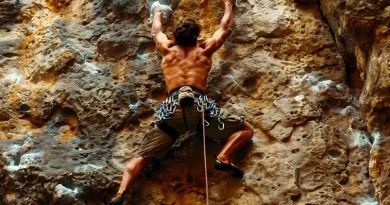
How Does Climbing Affect The Body?
The sun was climbing high in the sky as I approached the rock face, pondering the profound impact that climbing has on the body. “How does climbing affect the body?” It’s a question that goes beyond the obvious physical exertion, delving into the intricate changes that occur within us as we scale new heights. Here’s a detailed exploration of how climbing shapes and transforms the body, written through the lens of a climber’s journey.
Climbing is a full-body workout that engages a wide array of muscles, improves cardiovascular health, enhances mental well-being, and fosters a unique sense of community. But how exactly does climbing achieve all this? What are the specific effects on the body?
Options and Obstacles
To understand the comprehensive impact of climbing, we need to consider its effects on various bodily systems and the potential challenges involved:
1. Musculoskeletal System:
- Strength Building: Climbing develops strength in the forearms, biceps, shoulders, back, core, and legs. The dynamic movements and constant tension required to maintain grip and balance lead to significant muscle hypertrophy and endurance improvements.
- Muscle Imbalance: Overemphasis on certain muscle groups can lead to imbalances, particularly if complementary exercises are neglected.
2. Cardiovascular System:
- Cardio Workout: Climbing elevates the heart rate, providing a robust cardiovascular workout. Long routes and continuous climbing enhance heart and lung function, akin to traditional aerobic exercises.
3. Flexibility and Coordination:
- Flexibility: The diverse range of movements required, from high steps to intricate handholds, enhances overall flexibility.
- Coordination and Balance: Climbing improves balance and coordination as climbers learn to distribute their weight effectively and move precisely.
4. Mental and Emotional Benefits:
- Stress Reduction: Physical exercise, including climbing, reduces stress hormones like cortisol and increases endorphins, improving mood and reducing anxiety.
- Problem Solving: Each climb presents a unique puzzle, enhancing problem-solving skills and cognitive function.
- Mindfulness: The intense focus required during climbing promotes mindfulness, helping climbers stay present and mentally clear.
The Best Solution
To fully reap the benefits of climbing while minimizing risks, climbers should adopt a well-rounded approach that includes physical training, proper technique, mental conditioning, and community support.
1. Comprehensive Training:
- Strength and Endurance: Incorporate exercises like pull-ups, planks, and leg presses to build the necessary strength. Focus on both upper and lower body workouts to maintain muscle balance.
- Flexibility and Mobility: Regular stretching and yoga can enhance flexibility and prevent injuries.
2. Proper Technique:
- Professional Guidance: Learning proper techniques from experienced climbers or coaches can prevent bad habits and reduce the risk of injury.
- Consistent Practice: Regular climbing practice, both indoors and outdoors, helps refine skills and build confidence.
3. Mental Conditioning:
- Mindfulness Practices: Techniques such as deep breathing, meditation, and visualization can improve focus and reduce anxiety.
- Problem-Solving Drills: Engage in climbing puzzles and varied routes to enhance cognitive skills and adaptability.
4. Community and Support:
- Climbing Partners: Climbing with a trusted partner can provide emotional support and enhance safety through effective communication.
- Climbing Groups and Gyms: Joining a climbing community fosters a sense of belonging and provides access to shared knowledge and resources.
Resources and Tools
- Climbing Gyms: Offer controlled environments for practice and skill development.
- Outdoor Gear Retailers: Provide necessary equipment like climbing shoes, harnesses, and protective gear.
- Books and Guides: Titles like “Learning to Climb Indoors” and “Rock Climbing: The Art of Safe Ascent” offer valuable insights and tips.
- Online Communities: Websites and forums where climbers can share experiences and advice.
Conclusion
As I reached the summit, the vast landscape unfolding beneath me, I reflected on the transformative power of climbing. “How does climbing affect the body?” It’s a journey of strength, endurance, flexibility, and mental fortitude. Each climb shapes us, not just physically but emotionally and mentally, creating a holistic impact that extends beyond the rock face. Embrace the climb, and you’ll find that the benefits reach far beyond the summit.
By integrating these practices and leveraging available resources, you can maximize the positive effects of climbing on your body and mind. Happy climbing!






